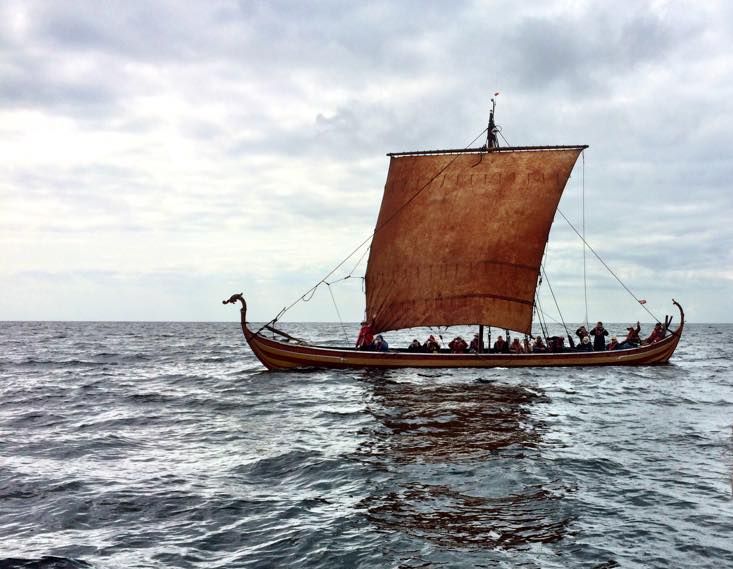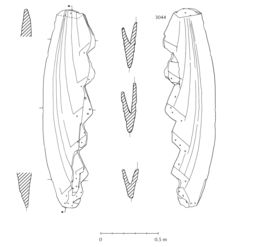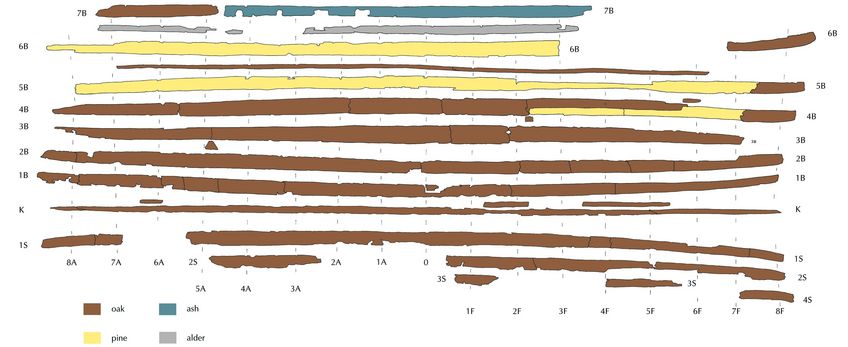Skuldelev 5
Skuldelev 5 was found during underwater investigations by divers in Peberrenden, Roskilde Fjord in 1959, and was excavated together with the other Skuldelev ships in 1962. The ship's port side in particular is well preserved and the vessel could be reconstructed as an oar-powered ship, 17.3 m long, 2.47 m wide and 1.16 m deep midships, and with 13 pairs of oars. Scanty remains of the keelson show that it had also been equipped with a mast and sail. Its construction date has been established with the aid of dendrochronological investigations as being shortly after AD 1024. These investigations also revealed that the ship was built within the borders of medieval Denmark. A wooden list running along the gunwale behind which the crew could place their shields, shows that the vessel was undoubtedly a warship. It is provably an example of the smallest category of warship, a snekkja, as mentioned in written sources from late Viking times and the early Middle Ages.
The well-preserved stem was carved from a curved piece of timber so that in towards the ship it has the form of a series of steps. A V-shaped cut on the rear edge made it possible to attach the planks making up the hull to the stem with rivets, i.e. rivets which were pushed through and cold-hammered over a plate which functioned as both nut and washer. The sides of the stem have been carved such that they give the impression that the planks of the hull continue all the way up to the tip of the stem.
One of the remarkable aspects of Skuldelev 5 is that the ship was, to a great extent, built of re-used timber. Large parts of the three upper rows of planks and a single large rib had previously been part of other vessels. A long plank in the upper row in which the oar holes have been carved, even had the same position in another ship. A series of partially mended/filled in oar holes are seen about 78 cm apart, which must have been the rib spacing on the earlier ship, whereas the oar holes for Skuldelev 5 were cut about 90 cm apart. This re-use could have been due to the fact that the plank is of ash, and this was perhaps seen as particularly good material for just this purpose.
The two other re-used planks are of pine, as is the re-used piece of rib timber. As Viking shipbuilders normally preferred oak, when it was available, the re-use of timber could just be an expression of the lack of suitable ship-building timber. However, as both planks are very long – one is 10.5 m and the other an impressive 14 m – it is likely that it was their length which made these planks attractive to use. Long planks in the hull contribute to the strength of a longship and are of great importance in the long, narrow constructions seen in these vessels.
Another prominent feature of Skuldelev 5 are the extensive repairs, which had been carried out on the hull during the lifetime of the ship. These include the replacement of part of the keel and several planks in the bow section. The extent of the repairs and the use of re-used ship components have prompted the theory that the vessel was, perhaps, a leidang ship. In the early Middle Ages, the population was obliged to build these ships which then stood ready for coastal defence, transport and military expeditions.
Skuldelev 5 was recreated as a sailing reconstruction with the name Helge Ask by the Viking Ship Museum in 1990-1991 and is today part of the Museum's collection of vessels.
Danish text: Jan Bill
Translation: Gillian Fellows-Jensen
Archaeological findings of longships
Learn more about the longships we know today. Some were found in burial mounds, others in the Viking's harbours and others were recycled by the Vikings as part of defense systems of their main towns.
Below you can find links to read more about the longships.
» Ladby - the ship in the grave
» The longship from Haithabu Harbour


